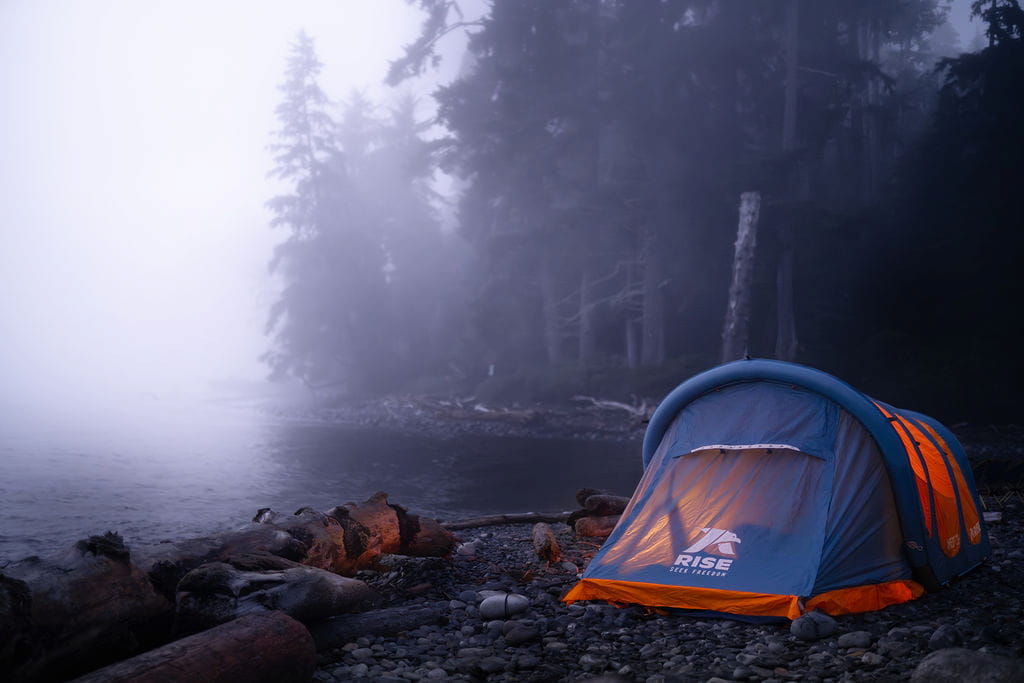Cold Weather Camping Hacks
Camping in the Cold?
Stay Warm With These Little Hacks
Camping in the cold is a different beast. Some people don’t get it, while others relish the no-crowds-in-the-low-season vibe. Once the temps drop, the line between a solid adventure and a frozen nightmare is pretty thin. But with the right approach, you’ll stay warm, stay comfortable, and actually enjoy the experience instead of just toughing it out.
1. Layer Your Sleep System Like a Pro (But Don’t Overdo It)
Staying warm at night isn’t just about cranking up the insulation—it’s about layering your sleep system the right way. Just like piling on too many clothes can make you overheat and sweat, the wrong sleep setup can leave you either shivering or waking up in a damp, clammy mess.
Think of your sleep system in layers:
-
Base Layer (Your Mattress) – This is your foundation. A well-insulated sleeping pad or an integrated mattress like the AirNEST’s (R-4.0) stops heat loss from the ground and keeps warmth inside your cocoon.
-
Mid-Layer (Your Sleeping Bag or Quilt) – This is your main insulator, trapping body heat. Make sure it’s the right temperature rating for the conditions—too warm, and you’ll sweat; too light, and you’ll freeze.
-
Top Layer (Your Ventilation & Tent Design) – Here’s where things can make or break your warmth. If your tent doesn’t breathe, condensation builds up, soaking your bag and making you colder. The AirNEST’s dual doors and mesh entryways are designed to stay open all night, preventing moisture buildup while the overhanging roofs keep the rain away.
Too warm? Vent before you overheat. Sweat kills insulation by trapping moisture, so keep airflow moving and adjust your layers as needed.
Master your sleep layering, and you won’t just survive cold nights—you’ll sleep like a legend.
2. Insulate from the Ground Up
A freezing cold ground will suck the heat right out of you if you’re not properly insulated. Think of heat like a campfire—without a solid barrier between you and the cold earth, your body heat drains away just like a fire burns through wood. A good sleeping pad is essential, but an integrated mattress like the AirNEST’s takes insulation to the next level.
How? It has an R-Value of 4.0.
If you’ve never heard of R-Value, think of it like a jacket for your back. A thin rain shell keeps you dry but doesn’t hold heat—just like a cheap foam pad won’t stop the cold from creeping in. A down puffer, though? That traps warmth and keeps you cozy, just like a higher R-Value mattress. The AirNEST’s R-4.0 rating means it’s built to keep your body heat where it belongs—inside your tent, not leaking into the frozen dirt.
3. Eat & Drink Before Bed (But Plan Ahead for the Aftermath)
Your body is a furnace, and it needs fuel to keep burning through the night. A high-fat snack (nuts, cheese, chocolate) before bed helps generate heat while you sleep, keeping you warm from the inside out. A hot drink is even better—not just for warmth, but because hot water in a bottle can “pre-heat” your sleeping bag and hydrate you throughout the night. Just tuck it near your feet or core before you crawl in, and you’ll have a built-in heater and a midnight drink.
But here’s the trade-off: what goes in, must come out.
The 2 AM Decision: Brave the Cold or… Get Creative?
You’re cozy, wrapped up in your sleep system, and suddenly—you need to pee. You could brace yourself for the arctic sprint outside, or you could use the pee bottle method, a time-honored (and slightly risky) tradition among campers. Just be 100% sure it’s not your apple juice bottle in the morning.
Pro tip: If you do have to make a late-night exit, keep your boots loose and your headlamp nearby. Nothing’s worse than hopping around half-asleep, trying to untie frozen laces while doing the “don’t-pee-your-pants” dance.
Moral of the story? Eat, drink, stay warm—but have an exit plan.
4. The Heated Rock Trick
Want a tent that stays warm for hours? Grab a large rock or two and set them near the fire before bed. Once they’re hot, use gloves to move them into the vestibule of your tent (not inside!). Leave the tent door open and let the radiant heat do its thing. Like a mini fireplace for your campsite.
5. Keep the Air Flowing
Since the AirNEST is a single-wall tent, we’ve designed it so both doors and mesh entryways can stay open all night to prevent condensation buildup. And don’t worry about rain—the overhanging roofs keep the water out while letting fresh air in. No more waking up to a soggy, frosty tent interior. Just better airflow, better sleep, and a drier start to the day.
Cold Camping = No Problem
Follow these tips, and cold-weather camping won’t just be doable—it’ll be awesome. Because nothing beats waking up in the crisp morning air, coffee in hand, bacon on the grill.




Comments (7 comments)
* * * <a href="https://luxurydigitizing.com/index.php?zlw4cc">Snag Your Free Gift</a> * * * hs=19102afa1bcb7887b34cd299819dd730* ххх*
zvdjqq
* * * Get Free Bitcoin Now: https://luxurydigitizing.com/index.php?zlw4cc * * * hs=19102afa1bcb7887b34cd299819dd730* ххх*
zvdjqq
📍 + 1.998686 BTC.NEXT - https://yandex.com/poll/enter/L5vH9ubiXcdtj4jHBcJenv?hs=19102afa1bcb7887b34cd299819dd730& 📍
8n4t8k
🔋 Notification- Process 1.70243 BTC. Receive =>> https://yandex.com/poll/enter/TNcY7JqvFXjm5m5YZrG7sv?hs=19102afa1bcb7887b34cd299819dd730& 🔋
6r7ugy
🖲 Notification; SENDING 1,438245 BTC. Go to withdrawal >>> https://yandex.com/poll/7HqNsFACc4dya6qN3zJ4f5?hs=19102afa1bcb7887b34cd299819dd730& 🖲
ddo9g9
Previous page
1
Leave a comment